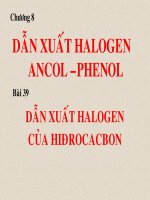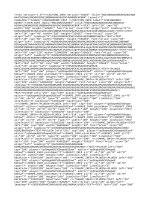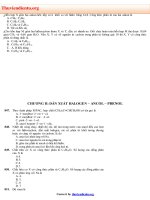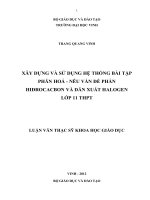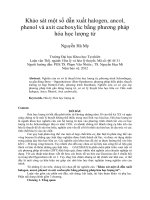Dan xuat halogen
Bạn đang xem bản rút gọn của tài liệu. Xem và tải ngay bản đầy đủ của tài liệu tại đây (285.78 KB, 26 trang )
<span class='text_page_counter'>(1)</span>HOÁ HỌC HỮU CƠ Organic Chemistry CHÖÔNG 9 (T.T) DAÃN XUAÁT HALOGEN & HC CÔ-Mg.
<span class='text_page_counter'>(2)</span> Hợp chất cơ kim Organometallic Compounds.
<span class='text_page_counter'>(3)</span> Danh pháp Organometallic Nomenclature.
<span class='text_page_counter'>(4)</span> Metal is the parent. Li. H2C. CHNa. Cyclopropyllithium. Vinylsodium. CH3CH2MgCH2CH3. CH3MgI. Diethylmagnesium. Methylmagnesium iodide.
<span class='text_page_counter'>(5)</span> Carbon-Metal Bonds in Organometallic Compounds.
<span class='text_page_counter'>(6)</span> Table 14.1 (p 588) F O N C H. 4.0 3.5 3.0 2.5 2.1. H Cu Zn Al Mg Li Na K. 2.1 1.9 1.6 1.5 1.2 1.0 0.9 0.8.
<span class='text_page_counter'>(7)</span> Polarity of Bonds. + R. – X. – R. + M. organometallics are a source of nucleophilic carbon.
<span class='text_page_counter'>(8)</span> Polarity of Bonds. CH3F. CH3Li.
<span class='text_page_counter'>(9)</span> Preparation of Organolithium Compounds.
<span class='text_page_counter'>(10)</span> Organolithium Compounds normally prepared by reaction of alkyl halides with lithium R. X + 2Li. R. same for Ar—X is an oxidation-reduction reaction: carbon is reduced. Li + LiX.
<span class='text_page_counter'>(11)</span> Examples. (CH3)3CCl + 2Li. diethyl ether –10°C. (CH3)3CLi + LiCl (75%). diethyl ether Br + 2Li. Li + LiBr 35°C (95-99%).
<span class='text_page_counter'>(12)</span> Electron Bookkeeping. R. [R X]. X + Li •. R ••Li. Li•. •–. R• +. + Li+. •• X–.
<span class='text_page_counter'>(13)</span> Preparation of Organomagnesium Compounds: Grignard Reagents.
<span class='text_page_counter'>(14)</span> Grignard Reagents prepared by reaction of alkyl halides with magnesium R. X + Mg. RMgX. same for Ar—X Diethyl ether is most often used solvent. Tetrahydrofuran is also used..
<span class='text_page_counter'>(15)</span> Examples diethyl ether Cl + Mg. MgCl –10°C (96%) diethyl ether. Br + Mg. MgBr 35°C (95%).
<span class='text_page_counter'>(16)</span> Electron Bookkeeping. R. •. [R X]. X + Mg •. •–. •. + Mg+. •. Mg+ R •• Mg+. •• X–. R• +. •• X–.
<span class='text_page_counter'>(17)</span> Order of Reactivity. I > Br > Cl >> F RX > ArX.
<span class='text_page_counter'>(18)</span> Forbidden Groups certain groups cannot be present in the solvent the halide from which the Grignard reagent is prepared the substance with which the Grignard reagent reacts.
<span class='text_page_counter'>(19)</span> Forbidden Groups Anything with an OH, SH, or NH group therefore cannot use H2O, CH3OH, CH3CH2OH, etc. as solvents cannot prepare Grignard reagent from substances such as HOCH2CH2Br, etc..
<span class='text_page_counter'>(20)</span> Organolithium and Organomagnesium Compounds as Brønsted Bases.
<span class='text_page_counter'>(21)</span> Brønsted basicity. – R M. H. +. •• OR' ••. R. H. + –• •• M • OR' ••. Grignard reagents (M = MgX) and organolithium reagents (M = Li) are strong bases..
<span class='text_page_counter'>(22)</span> Example. CH3CH2CH2CH2Li. + H2O. CH3CH2CH2CH3. +. (100%). LiOH.
<span class='text_page_counter'>(23)</span> Example. MgBr + CH3OH. + (100%). CH3OMgBr.
<span class='text_page_counter'>(24)</span> Table 14.2 Approximate Acidities Compound (CH3)3CH. pKa 71. Hydrocarbons are very weak acids.. CH3CH3. 62. CH4. 60. Ethylene Benzene Ammonia Acetylene Water. 45 43 36 26 16. Their conjugate bases are very strong bases. Grignard reagents and organolithium reagents are strong bases..
<span class='text_page_counter'>(25)</span> Acetylenic Grignard Reagents are prepared by an acid-base reaction CH3CH2MgBr +. CH3CH3 weaker acid. +. HC CH stronger acid. HC. CMgBr.
<span class='text_page_counter'>(26)</span> Alkyl halides in Nature. Br MeO. HO N. H N. Br. O. O. Cytotoxic NH3+. -. X. Br. Aplysamine from Psammaplysilla purpurea.
<span class='text_page_counter'>(27)</span>



